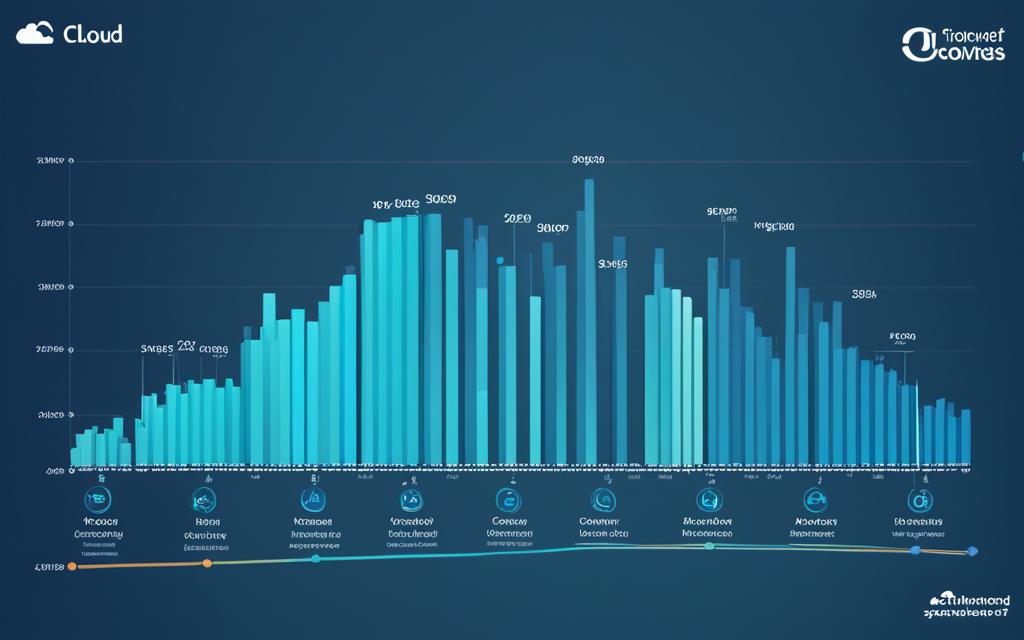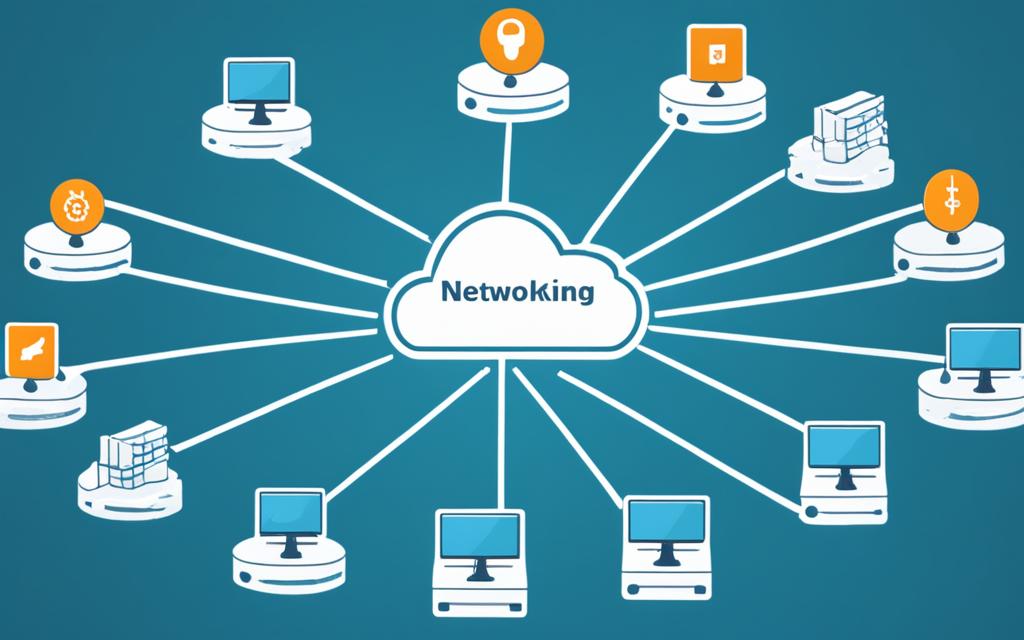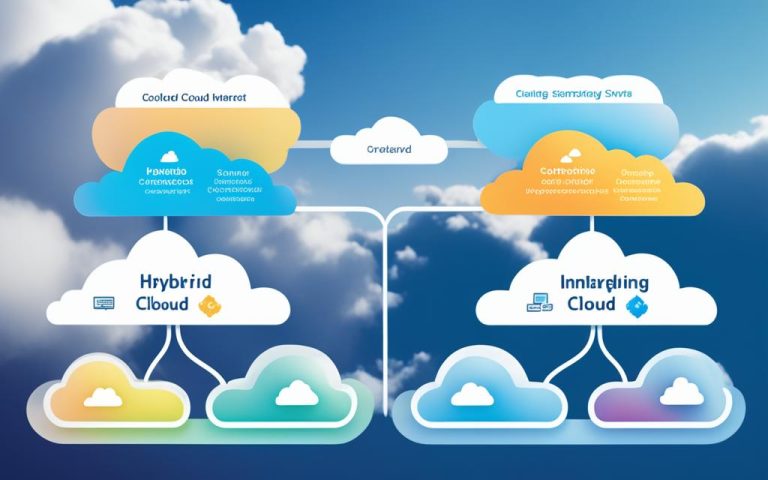Operating systems play a crucial role in managing and optimizing networking features in cloud environments. These features include on-demand self-service, resource pooling, scalability and rapid elasticity, pay-per-use pricing, measured service, resiliency and availability, security, and broad network access. These features enable seamless integration of applications and services in the cloud, providing organizations with flexibility, scalability, and enhanced performance.
On-demand self-service
On-demand self-service is a fundamental networking feature in cloud computing that enables users to provision resources and services instantly, without the need for manual intervention or lengthy procurement processes. Public cloud platforms such as AWS, Microsoft Azure, and Google Cloud offer on-demand self-service capabilities, allowing developers to quickly build and deploy applications in the cloud with just a click of a button or an API call.
With on-demand self-service, organizations can leverage the convenience and agility of cloud computing to meet their resource provisioning needs in a timely manner. This feature eliminates the wait time associated with traditional infrastructure procurement, enabling teams to launch applications and scale their infrastructure rapidly, ultimately driving business innovation and acceleration.
Administrators also have the ability to set policies and access controls to ensure security while granting employees the freedom to create, test, and deploy applications as needed. This empowers teams to experiment, iterate, and bring new products and services to market faster, without compromising on compliance and data protection.
On-demand self-service is a key enabler of cloud computing’s agility and flexibility, providing organizations with the ability to scale resources up or down based on demand, optimize cost efficiency, and deliver a seamless user experience. Whether it’s spinning up virtual machines, configuring networking components, or provisioning storage, on-demand self-service simplifies resource management and empowers businesses to leverage the full potential of the cloud.
By adopting on-demand self-service in their cloud environments, organizations can accelerate their digital transformation, reduce time-to-market, and gain a competitive edge in today’s rapidly evolving business landscape.
Resource pooling
Resource pooling is an essential networking feature in cloud environments. Cloud providers leverage multi-tenant architectures to accommodate multiple users on the same physical infrastructure, resulting in efficient resource utilization and cost savings for both the provider and the users.
By utilizing custom hardware and abstraction layers, cloud providers ensure the isolation of workloads and improve security. This allows organizations to confidently deploy their applications and services without worrying about interference or unauthorized access from other tenants.
Resource pooling is a key factor in enabling scalability and flexibility in the cloud. With shared resources, such as compute, storage, and networking, available on-demand, organizations can easily scale up or down based on their needs. This eliminates the need for upfront investments in hardware and allows for dynamic resource allocation.
Cloud providers employ advanced virtualization technologies to efficiently allocate and manage resources, ensuring optimal performance and utilization. By pooling resources, cloud providers can deliver cost-effective services and meet the demands of a diverse range of applications and workloads.
Benefits of Resource Pooling:
- Efficient resource utilization
- Cost savings for both providers and users
- Isolation and security for workloads
- Scalability and flexibility
- Dynamic resource allocation
“Resource pooling enables cloud providers to offer shared resources on-demand, allowing organizations to scale their infrastructure quickly and efficiently.”
| Advantages | Disadvantages |
|---|---|
| Cost savings through shared resources | Potential performance impact due to resource contention |
| Flexibility to scale resources as needed | Dependency on the reliability and availability of the provider’s infrastructure |
| Improved security through isolation of workloads | Possible compliance concerns with data segregation requirements |
Scalability and rapid elasticity
Scalability and rapid elasticity are critical networking features in cloud environments that empower organizations to meet changing demands and optimize performance. By leveraging resource pooling, cloud providers and users can easily add or remove computing, storage, and networking resources as required, ensuring seamless scalability and avoiding bottlenecks. Whether scaling vertically by increasing the capacity of existing resources or horizontally by adding more resources, cloud infrastructure offers the flexibility needed to adapt to fluctuating workloads.
This dynamic scaling is made possible through automation software provided by service providers. With automated scaling, organizations can effortlessly adjust their infrastructure based on real-time demand, eliminating the need for manual intervention. As a result, businesses can maintain optimal performance during peak periods while saving costs during periods of lower demand.
In cloud environments, rapid elasticity enables organizations to scale their infrastructure up or down swiftly, ensuring efficient resource allocation. This feature allows businesses to respond promptly to changing market conditions, customer demands, or unforeseen circumstances without disruptions. By leveraging scalability and rapid elasticity, organizations can achieve the agility and flexibility needed to stay competitive in today’s fast-paced digital landscape.
“Scalability and rapid elasticity are indispensable features in cloud environments, offering organizations the freedom to rapidly adapt and optimize their infrastructure as business needs change.”
Pay-per-use pricing
Pay-per-use pricing is a significant networking feature in cloud computing. Cloud providers offer per-second billing, shifting IT spending from capital expenditure (Capex) to operational expenditure (Opex). This pricing model enables organizations to pay only for the resources and services they consume, leading to cost optimization and efficiency gains.
However, organizations need to carefully manage their resource needs to avoid unnecessary expenses and ensure that virtual machines (VMs) are right-sized or scaled down when not in use.

Example Pricing Comparison
Let’s take a look at a comparison of pay-per-use pricing plans offered by three popular cloud providers:
| Cloud Provider | Pricing Model | Cost per Hour |
|---|---|---|
| AWS | On-Demand Instances | $0.02 |
| Microsoft Azure | Pay-As-You-Go | $0.03 |
| Google Cloud | Sustained Use Discounts | $0.025 |
As seen in the table above, the actual cost per hour can vary based on the cloud provider and the specific pricing model chosen by the organization. By carefully evaluating the pay-per-use pricing options and regularly monitoring resource utilization, organizations can effectively manage their cloud expenses and optimize costs.
For example, implementing auto-scaling policies can help scale resources up or down based on demand, ensuring that organizations pay for the actual resources they require at any given time.
Measured service
Measured service is an important networking feature in cloud environments. It allows cloud providers and customers to monitor and report on the usage of resources and services, such as virtual machines (VMs), storage, processing, and bandwidth. By collecting data on resource utilization, organizations can gain valuable insights into their resource consumption patterns.
This data enables organizations to optimize and make informed decisions about their resource utilization. By understanding how resources are being used, organizations can identify areas of inefficiency, adjust resource allocations, and ultimately improve their overall operational efficiency. This optimization helps organizations maximize the value of their cloud investments.
Benefits of measured service:
- Resource utilization optimization
- Cost management and optimization
- Performance optimization
- Capacity planning and forecasting
With measured service, organizations can align their resource usage with their business needs. By accurately measuring resource consumption and comparing it against predefined service-level agreements (SLAs), organizations can ensure that they are meeting their contractual obligations and performance targets.
By leveraging the insights provided by measured service, organizations can make data-driven decisions to optimize resource utilization, improve cost efficiency, and deliver high-quality services to their customers.
In addition, measured service is crucial for compliance purposes. Organizations may need to demonstrate to auditors and regulators that they are using resources efficiently and effectively. The ability to track and report on resource usage enables organizations to easily provide evidence of their compliance with industry standards and regulations.
Overall, measured service is a valuable networking feature that provides organizations with the necessary data and insights to optimize resource consumption, meet service-level agreements, and achieve cost efficiency in cloud environments.
| Benefits of Measured Service in Cloud Environments |
|---|
| Resource utilization optimization |
| Cost management and optimization |
| Performance optimization |
| Capacity planning and forecasting |
Resiliency and availability
Resiliency and availability are critical networking features in cloud data centers. Cloud providers implement various techniques to minimize downtime and ensure high availability of services. These include:
- Avoiding single points of failure through regional dependencies
- Extending workloads across availability zones
- Automatically distributing workloads
Cloud providers strive for maximum uptime, but it’s essential for organizations to have contingency plans in place to handle any potential outages or disruptions. By implementing these resiliency and availability measures, cloud data centers can effectively ensure the uninterrupted delivery of services to their users.
The Importance of Resiliency and Availability
Resiliency and availability are critical components of a successful cloud infrastructure. They help organizations maintain business continuity, enhance customer satisfaction, and minimize financial losses due to service disruptions. By leveraging advanced technologies and best practices, cloud providers can achieve high levels of resiliency and availability, ensuring that services remain accessible and reliable.
“Resiliency and availability are the backbone of a robust cloud infrastructure. By implementing comprehensive strategies and utilizing advanced technologies, organizations can minimize downtime and deliver seamless services to their users.”
Security
Security is a fundamental networking feature in cloud environments. Cloud providers invest in robust security measures to protect the infrastructure and defend against threats. They employ security experts and follow best practices in access control, monitoring, and software patching. However, cloud security follows a shared responsibility model, where providers are responsible for securing the platform, while users are responsible for securing their applications and data. Organizations must understand their responsibilities and take appropriate measures to ensure data protection in the cloud.
Shared Responsibility Model
The shared responsibility model is a crucial aspect of cloud security. It helps organizations understand their role in securing their applications and data in the cloud. While cloud providers take responsibility for securing the underlying infrastructure, including the physical data centers, networks, and hardware, users are accountable for managing the security of the applications, data, and access controls.
In this model, the cloud provider handles security measures such as physical security, host infrastructure, and network security. They implement firewalls, intrusion detection systems, and data encryption to safeguard the platform. Additionally, they perform regular security audits and updates to ensure a secure environment for users’ data.
On the other hand, users have the responsibility of securing their applications and data running on the cloud infrastructure. This involves implementing secure coding practices, managing user access controls, and encrypting sensitive data. Users should also monitor their applications for vulnerabilities, promptly apply security patches, and regularly update their security protocols.
Best Practices for Cloud Security
To ensure robust security in cloud environments, organizations should follow best practices:
- Implement strong access controls: Restrict access to data and applications based on the principle of least privilege, ensuring that only authorized users can access sensitive information.
- Encrypt sensitive data: Utilize encryption techniques to protect data at rest and in transit, safeguarding it from unauthorized access.
- Regularly update security protocols: Stay up to date with the latest security patches and updates to protect against known vulnerabilities.
- Implement monitoring and logging: Enable robust monitoring and logging mechanisms to detect and respond to potential security incidents promptly.
- Conduct regular security assessments: Perform regular security assessments, including vulnerability scans and penetration testing, to identify and address any weaknesses in the infrastructure.
By following these best practices and understanding their role in the shared responsibility model, organizations can enhance the security of their applications and data in the cloud.
Cloud Security Challenges
While cloud providers invest heavily in security, there are still challenges that organizations must consider:
- Data breaches: The risk of unauthorized access and data breaches is a significant concern in cloud environments. Organizations must implement appropriate security measures to safeguard against such incidents.
- Compliance: Organizations operating in regulated industries must ensure their cloud deployments comply with relevant data protection and privacy regulations.
- Data loss: Cloud data centers may experience outages or other technical issues that can result in data loss. It is essential for organizations to have backup and disaster recovery plans in place.
Addressing these challenges requires a proactive and holistic approach to cloud security. Organizations should regularly evaluate their security measures, stay informed about emerging threats, and collaborate with their cloud providers to ensure a robust security posture.
| Cloud Security Best Practices | Cloud Security Challenges |
|---|---|
| Implement strong access controls | Data breaches |
| Encrypt sensitive data | Compliance |
| Regularly update security protocols | Data loss |
| Implement monitoring and logging | |
| Conduct regular security assessments |
Conclusion
Networking features play a crucial role in optimizing performance and enhancing security in cloud environments. Operating systems that support these features enable organizations to fully leverage the benefits of the cloud, including seamless integration, flexibility, scalability, and enhanced performance.
Key networking features in operating systems for cloud environments include on-demand self-service, resource pooling, scalability and rapid elasticity, pay-per-use pricing, measured service, resiliency and availability, security, and broad network access.
By understanding and utilizing these networking features, organizations can unlock the full potential of their cloud infrastructure. On-demand self-service allows for quick and easy provisioning of resources, enabling developers to build and deploy applications with ease. Resource pooling ensures efficient utilization of resources and cost savings for both cloud providers and users. Scalability and rapid elasticity enable organizations to dynamically adjust their infrastructure to meet changing demands, while pay-per-use pricing promotes cost optimization and efficiency gains.
Measured service provides valuable insights into resource utilization, helping organizations make informed decisions and comply with service-level agreements. The resiliency and availability of cloud data centers minimize downtime, ensuring high availability of services. Security measures implemented by cloud providers protect the infrastructure, while organizations have a shared responsibility in securing their applications and data.
By embracing these networking features in operating systems for cloud environments, organizations can achieve a robust and efficient cloud infrastructure that enables them to thrive in today’s digital landscape.
FAQ
What are networking features in operating systems for cloud environments?
Networking features in operating systems for cloud environments include on-demand self-service, resource pooling, scalability and rapid elasticity, pay-per-use pricing, measured service, resiliency and availability, security, and broad network access.
How does on-demand self-service work in cloud computing?
On-demand self-service in cloud computing allows users to easily provision resources and services with just a click of a button or an API call. This feature eliminates the need for lengthy procurement processes and enables developers to quickly build and deploy applications in the cloud.
What is resource pooling in cloud environments?
Resource pooling in cloud environments refers to the utilization of multi-tenant architectures, where multiple users share the same physical infrastructure. This allows for efficient utilization of resources and enables cost savings for both the cloud provider and the users.
How do scalability and rapid elasticity work in cloud environments?
Scalability and rapid elasticity in cloud environments allow for the addition or removal of computing, storage, and networking resources as needed. This ensures optimal performance, avoids bottlenecks, and allows organizations to scale their infrastructure up or down seamlessly in response to changing demands.
What is pay-per-use pricing in cloud computing?
Pay-per-use pricing in cloud computing refers to the pricing model where organizations pay only for the resources and services they consume. This model shifts IT spending from capital expenditure (Capex) to operational expenditure (Opex), leading to cost optimization and efficiency gains.
How does measured service work in cloud environments?
Measured service in cloud environments allows for the monitoring and reporting of resource usage, such as virtual machines, storage, processing, and bandwidth. This data is used to calculate resource consumption and provides insights for optimizing resource utilization.
How are resiliency and availability ensured in cloud data centers?
Resiliency and availability in cloud data centers are ensured through techniques such as avoiding single points of failure, extending workloads across availability zones, and automatically distributing workloads. While cloud providers strive for maximum uptime, organizations should have contingency plans in place to handle outages or disruptions.
How is security addressed in cloud environments?
Security in cloud environments is addressed through robust measures implemented by cloud providers to protect the infrastructure and defend against threats. However, cloud security follows a shared responsibility model, where providers are responsible for securing the platform while users are responsible for securing their applications and data.
What are the benefits of networking features in operating systems for cloud environments?
Networking features in operating systems for cloud environments enable seamless integration of applications and services, providing organizations with flexibility, scalability, enhanced performance, and improved cost optimization.



















